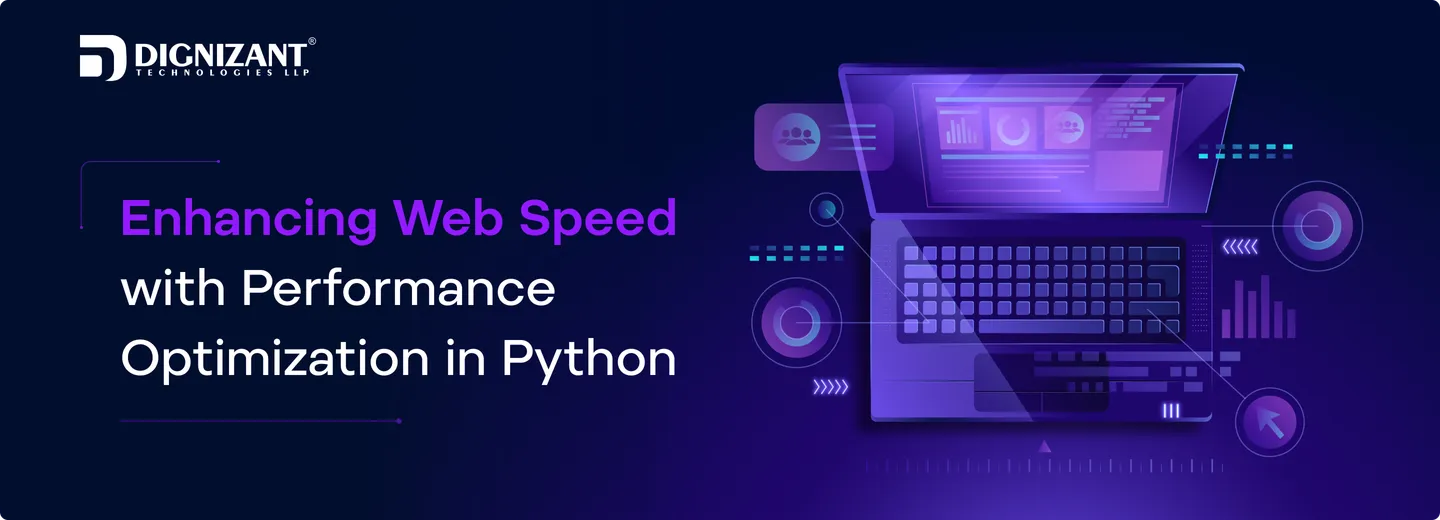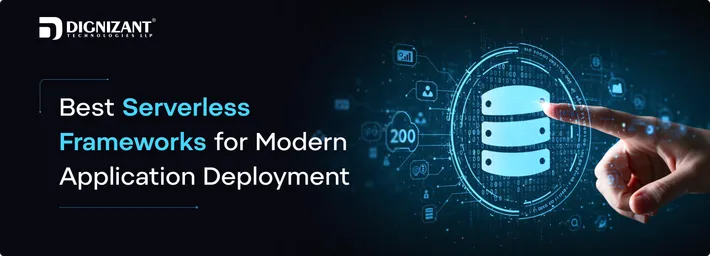Enhancing Web Speed with Performance Optimization in Python

Contributor
Vinil Joseph
Uploaded
11 November, 2025
Read Time
6 Minutes
Speed in today’s hyper-connected digital world is not merely a convenience, but a currency. The performance of a web application is directly related to the satisfaction of its users, search engine ranking and the success of its business. Nowadays, when an extra second can cause conversions and engagement to drop, optimization is not a choice, it's a necessity.
Python, with its simple yet readable syntax, supports hundreds of thousands of web applications and data-driven systems. Still, developers struggle with performance because of Python being an interpreted language and resource allocation. The good news? Python can provide fast and highly scalable web experiences with the right tools and strategy.
In this post, this article explores the art and science of performance optimization in Python to help your Python-powered web applications become as easy to maintain and perform as they should be.
Why Performance Optimization Matters
Performance optimization isn’t just about speed, it's about scalability, efficiency, and cost-effectiveness. A slow application:
- Combating User pay and high bounce rates.
- Negatively impacts SEO rankings.
- Costs infrastructure by ineffective employment of resources.
- Diminishes user conversion rates and trust.
Performance tuning helps you to make sure that your Python web application is running smoothly and serves response consistently under different numbers of loads for users.
Common Performance Bottlenecks in Python Web Applications
You need to figure out what slows your app down first, though. Common culprits include:
- Inefficient Code Loops and Algorithms
Sloppy algorithms, unneeded loops and inefficient iterations can all suck up valuable CPU time. - Blocking I/O Operations
Blocking synchronous operations, such as a request to be blocked while processing concurrent connections can take much longer. - Inefficient Database Queries
Repeated or non-indexed queries result in "large" latencies and response times. - Memory Leaks and High Resource Consumption
When resources are not managed properly leads to more memory and CPU usage of the application. - Lack of Caching
If data is not cached, you’ll make redundant computations and fetch the same data again and again. - Unoptimized Framework Configuration
Misconfigured servers or frameworks such as Django, Flask or FastAPI, throughput and concurrency can be reduced.
An understanding of these bottlenecks enables developers to apply targeted optimizations.
Step-by-Step Guide to Python Performance Optimization
1. Identify What’s Slowing You Down (Profiling Phase)
All performance optimization in Python starts with visibility. You can’t improve what you can’t measure. With the aid of profiling tools you can find bottlenecks before commencing changes.
How to do it:
- Leverage profiling tools such as cProfile, Py-Spy or Scalene to trace down high time-consuming or high memory consuming columns.
- Record things like response time, database latency and CPU usage.
- Leverage monitoring dashboards such as New Relic, Datadog, Prometheus for ongoing visibility.
Goal: Build a performance baseline. You cannot improve what you cannot measure.
2. Review Your Architecture and Framework Choices
Not every project has the same framework, nor do you have to set up that way. So you have lightweight, fast frameworks like FastAPI and Flask, on the other hand, you have Django which gives more structure but can seem bloated if not necessary.
Checklist:
- Make sure that the framework corresponds to your scale and complexity of the project.
- Check your server setup. You should use modern web servers such as Uvicorn or Gunicorn.
- Serve static assets through CDNs and not directly.
Objective: Use the right tools for the right workload.
3. Optimize the Data Flow and Database Layer
The most common performance limitation is database interaction. Efficient use of data is the key to successful performance optimization in Python.
Best Practices:
- Create indexes for fields that are query-able often in the database.
- Use systems such as Redis or Memcached to cache read-heavy queries.
- Don't be wasteful, run only the contrary queries.
- Employ connection combining to optimally recycle the already existing database connections.
Goal: Serve fast and avoid redundant requests.
4. Introduce Caching for Frequently Accessed Data
Caching means provisionally storing copies of data so the system doesn’t have to recalculate or refetch it each time.
What to Cache:
- User sessions
- Static content (images, stylesheets)
- Frequently accessed database results
Where to Cache:
- In-memory caches (Redis, Memcached)
- Content Delivery Networks (CDNs) for static assets
- Framework native systems of application-level cache
Goal: Avoid cost and performance-expensive computations including the database
5. Improve Application Responsiveness with Asynchronous Processing
Contemporary Python optimization focuses on concurrent and non-blocking processing. This makes tasks to consider scheduling of everything without blocking the completion of any.
Strategic Actions:
- Use asynchronous frameworks (FastAPI, Aiohttp).
- Push long running tasks (emails, report generating) to a background worker like Celery or RQ.
- Allow I/O not to be blocking for APIs and files.
Goal: Application should be responsive even when load is high.
6. Manage Memory and Resource Usage Efficiently
Python code that is not optimized can take an enormous amount of space, slowing down the output process and may also lead to a program crash.
Preventive Steps:
- Profile memory like systems such as memory_profiler and object graph overviews such as objgraph.
- Find and plug memory leaks (eg unused references).
- Use generators or streams for large data sets, rather than loading everything into memory at once.
Goal: Always low memory footprint in data scaling.
7. Compress, Minify, and Streamline Front-End Assets
An optimized backend is worthless if the front-end is too long to download.
Recommendations:
- Server responses should be compressed using gzip or Brotli.
- Optimize CSS, JavaScript and HTML files.
- Lazy load images and scripts that are not immediately required.
- Load heavy files closer to the user with CDNs.
Goal: Speed page loads and decrease bandwidth consumption.
8. Deploy with High-Performance Configurations
Performance maximization lasts even after development deployment counts.
Recommendations:
- Compress the server responses with gzip or Brotli.
- Minify CSS, JavaScript and HTML files.
- Use lazy loading for images and scripts that readers do not immediately see.
- Utilize CDNs to deliver large files in proximity to the end user.
Goal: Boost page loads and cut down on bandwidth use.
9. Automate Performance Testing
Testing once is not enough. With every new incremental change, your codebase can slow you down.
Automation Practices:
- Include the use of load-testing tools as Locust via JMeter in your CI/CD pipeline.
- Set performance goals (such as response time limits, or acceptable latency).
- Run stress tests ahead of each major release.
Objective: Stable performance over updates.
10. Monitor and Iterate Continuously
Performance Optimization is not a one-time endeavor. Real-time insight to maintain your app healthy, no matter how many people use it.
Tracking Strategies:
- Leverage real-time dashboards for CPU, memory and request latency.
- Monitor for outliers in response times.
- Get users’ feedback on the responsiveness of your apps.
Objective: Catch slowness regressions early and be able to react before it impacts users.
Conclusion
The performance optimization in Python is a rinse and repeat cycle of measurement, improvement, measurement. If you implement these 15 best practices such as profiling and caching, monitoring and scaling your Python web apps you can turn them into high-performance, reliable, scalable systems.
In a world in which users demand an immediate response, performance is quality. It doesn’t matter whether you’re in charge of a startup platform or a global enterprise system, by following these non-code optimization steps your Python applications can run efficiently now and in the long term.
Latest Articles

Deploy modern apps faster with top serverless frameworks. Compare features, DX, scaling, cost controls, and CI/CD fit for production-ready releases.

Build secure, intelligent financial platforms with advanced fintech web development designed for speed, compliance and exceptional user experience.

Unlock mobile success by selecting the Best Tech Stack that boosts reliability, enhances UX, and supports long-term app evolution.
FAQs
Ready to Take Your Business to the Next Level?
Unlock new opportunities with expert solutions designed to elevate your brand. From strategy to execution, we empower your business with the tools, technology and talent it needs to thrive in today’s digital world.



